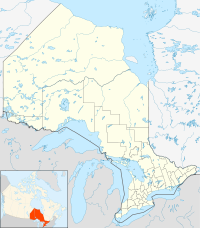- Munsee-Delaware Nation 1, Ontario
-
Munsee-Delaware Nation 1 — Indian reserve — Coordinates: 42°48′N 81°29′W / 42.8°N 81.483°WCoordinates: 42°48′N 81°29′W / 42.8°N 81.483°W Country  Canada
CanadaProvince  Ontario
OntarioCounty Middlesex Settled Formed 1967 Government – Chief Patrick Waddilove – Federal riding Lambton—Kent—Middlesex – Prov. riding Lambton—Kent—Middlesex Area[1] – Land 11.22 km2 (4.3 sq mi) Population (2009)[1] – Total 167 – Density 14.9/km2 (38.6/sq mi) Time zone EST (UTC-5) – Summer (DST) EDT (UTC-4) Postal Code N0L Area code(s) 519 and 226 The Munsee-Delaware Nation No. 1 is an Indian reserve on the Thames River, 24 kilometres (15 mi) west of St. Thomas, Ontario, Canada, and belongs to the Munsee-Delaware First Nation. The reserve is splintered into several non-contiguous areas, made up of individual lots within the Chippewas of the Thames reserve.
Members of the Munsee branch of the Lenape (Delaware) nation arrived in the area in the eighteenth century. The Lieutenant-Governor, John Graves Simcoe, encouraged the Munsee to settle there although Chippewa were already established there. In 1819 the Chippewa of the Thames reserve was established, and in 1840 the Munsee and the Chippewa finally reached an agreement to share the land. In 1967 the Munsee portion became part of the current reserve, which was established by Order in Council., February 2011
Contents
Demographics
The Munsee-Delaware First Nation had a registered population of 524 in April 2004, of whom 163 lived on the reserve. By January 2011, the nation had a total registered population of 555, of whom 145 lived on the reserve.[2]
Canada census – Munsee-Delaware Nation 1, Ontario Community Profile 2006 Population:
Land area:
Population density:
Median age:
Total private dwellings:
Mean household income:167 (% from 2001)
11.22 km2 (4.33 sq mi)
14.9 /km2 (39 /sq mi)
27.8 (males: 28.5, females: 26.5)
72
See also
References
- ^ a b "Munsee-Delaware Nation 1 community profile". 2006 Census data. Statistics Canada. http://www12.statcan.gc.ca/census-recensement/2006/dp-pd/prof/92-591/details/page.cfm?Lang=E&Geo1=CSD&Code1=3539018&Geo2=PR&Code2=35&Data=Count&SearchText=Munsee-Delaware&SearchType=Begins&SearchPR=01&B1=All&Custom=. Retrieved 2011-02-18.
- ^ Indian and Northern Affairs Canada - First Nation Profiles: Registered Population Munsee-Delaware Nation
- ^ "2006 Community Profiles". Statistics Canada. Government of Canada. 2009-02-24. http://www12.statcan.ca/census-recensement/2006/dp-pd/prof/92-591/index.cfm?Lang=E. Retrieved 2011-02-18.
External links
- Southern First Nations Secretariat: Munsee-Delaware First Nation
- MUNSEE-DELAWARE NATION 1 at Aboriginal Canada Portal
- Munsee-Delaware First Nation at Chiefs of Ontario

Chippewas of the Thames FN 42 
Chippewas of the Thames FN 42 
Chippewas of the Thames FN 42  Munsee-Delaware Nation 1
Munsee-Delaware Nation 1 

Thames River / Southwold Union of Ontario Indians Lake Superior Region Biinjitiwabik Zaaging (Rocky Bay) • Bingwi Neyaashi (Sand Point) • Fort William • Gull Bay • Long Lake 58 • Michipicoten • Namaygoosisagagun • Pays Plat • Pic Mobert • Pic River (Heron Bay) • Red Rock (Lake Helen) Lake Huron Region Atikameksheng (Whitefish Lake) • Aundeck-Omni-Kaning (Sucker Creek) • Dokis • Garden River • Henvey Inlet • Magnetawan • M'Chigeeng (West Bay) • Mississauga • Nipissing • Sagamok • Serpent River • Sheguiandah • Sheshegwaning • Thessalon • Wahnapitae • Wasauksing (Parry Island) • Whitefish River • Wikwemikong • Zhiibaahaasing (Cockburn) Southwest Region Aamjiwnaang (Sarnia) • Kettle & Stony Point • Munsee-Delaware • Thames Chippewa Southeast Region Alderville • Beausoleil (Christian Island) • Curve Lake • Georgina Island • Scugog Island • Moose Deer Point • Pikwàkanagàn Categories:- Union of Ontario Indians
- First Nations reserves in Ontario
- Western Ontario geography stubs
Wikimedia Foundation. 2010.

